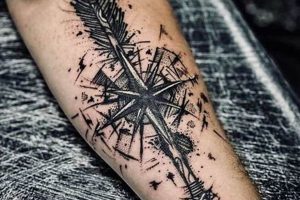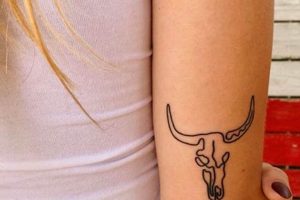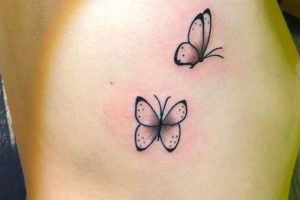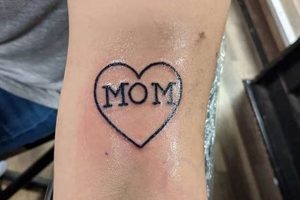Minimalist and easily executed designs for leg tattoos encompass a broad range of options, from delicate line art and small symbolic imagery to single-word inscriptions and geometric patterns. Examples include fine-line floral motifs, small animal silhouettes, or concise textual representations of significant dates or phrases.
Less complex designs often translate to quicker application times and potentially lower costs, making them an appealing entry point for first-time recipients. They also tend to age well due to their clean lines and minimal detailing. Furthermore, the understated aesthetic of such tattoos can offer versatility, allowing for easy integration with other body art or adaptation to changing personal styles over time. Historically, smaller, symbolic tattoos have held cultural significance across numerous societies, serving as markers of identity, belief, or social standing.
This exploration will further examine various styles suitable for minimalist leg tattoos, discuss placement considerations based on anatomy and desired visibility, and provide guidance on collaborating with tattoo artists to achieve the desired outcome. Practical advice on aftercare will also be included to ensure the longevity and vibrancy of the chosen design.
Tips for Choosing Simple Leg Tattoos
Careful consideration of design elements, placement, and artist selection contributes significantly to a successful tattooing experience. The following tips offer guidance in navigating these critical aspects.
Tip 1: Prioritize Scalability. A design intended for a smaller area, such as the ankle or inside of the calf, may not translate well if later scaled up for a larger placement on the thigh. Consider future expansion possibilities from the outset.
Tip 2: Research Tattoo Artists. Seek artists specializing in the preferred style (e.g., fine line, minimalist, geometric). Review portfolios for quality and consistency.
Tip 3: Factor in Pain Tolerance. Areas with thinner skin or closer proximity to bone (ankle, shin) typically involve greater discomfort. Consider individual pain thresholds when selecting placement.
Tip 4: Reflect on Lifestyle and Profession. Visibility preferences based on attire and workplace dress codes should inform placement decisions.
Tip 5: Embrace Simplicity. Resist overcomplicating the design. A minimalist approach often yields the most impactful and timeless results.
Tip 6: Prepare for Aftercare. Commitment to proper aftercare is crucial for optimal healing and color retention. Research recommended procedures in advance.
Tip 7: Consider Placement and Body Shape. Certain designs can elongate or accentuate the natural lines of the leg, while others might detract. Discuss placement options with the chosen artist to find the most flattering approach.
Adhering to these guidelines can ensure a positive experience and a visually pleasing, long-lasting result. Careful planning and consideration are essential investments in a piece of body art meant to be enjoyed for years to come.
By considering these tips and exploring various options, individuals can confidently embark on their tattoo journey, ensuring a design that resonates with personal style and stands the test of time.
1. Placement
Placement is a pivotal factor in the overall impact of a leg tattoo. It dictates visibility, influences how the design interacts with the leg’s natural contours, and can even affect perceived meaning. A delicate floral design placed discreetly on the inner ankle conveys a different message than a bold geometric pattern wrapping around the thigh. Placement choices should consider not only aesthetics but also practical elements such as potential exposure to sunlight and friction from clothing.
Consider a small, symbolic tattoo, like a single word or a small geometric shape. Its placement on the outer ankle allows for easy display or concealment depending on footwear choices. In contrast, positioning the same design on the side of the calf, below the knee, creates a more consistently visible statement. Larger, flowing designs might follow the natural lines of the calf muscle, enhancing the leg’s shape, while a band-like design could encircle the thigh or ankle, mimicking jewelry. The interplay of design and placement offers diverse expressive possibilities.
Strategic placement maximizes the design’s visual appeal while respecting individual preferences for visibility and personal expression. Choosing a location should be a thoughtful process, balancing aesthetic considerations with practical lifestyle factors. This deliberate approach ensures the tattoo remains a source of satisfaction for years to come.
2. Size and scale
Size and scale are integral considerations in tattoo design, particularly for leg placements where the body’s contours and the design’s visibility interact dynamically. A thoughtfully chosen scale enhances the aesthetic impact and ensures the tattoo complements rather than overwhelms the leg’s natural lines. Proportion and balance are key factors, impacting both the visual appeal and the longevity of the design.
- Proportion to Body Area
A small, intricate design might suit the ankle or inner calf, while a larger, bolder piece could work well on the thigh. Disproportionately large designs on smaller areas can appear crowded and distort over time as the skin stretches and ages. Conversely, a small, delicate design on a larger area might appear lost or insignificant. Careful consideration of the interplay between design size and the chosen body area is crucial.
- Impact of Detail and Line Weight
Fine-line tattoos require smaller scales to maintain clarity, as intricate details can blur or lose definition when scaled up excessively. Bolder lines and simpler shapes, however, can be successfully scaled larger while retaining their impact. The intended level of detail directly informs the appropriate size of the tattoo. A delicate floral pattern demands a different scale than a bold tribal design.
- Long-Term Visual Appeal
Over time, tattoos can fade or lose some definition. Smaller, simpler designs tend to age more gracefully than larger, complex pieces with intricate details. Choosing a scale that considers the long-term visual appeal ensures the tattoo remains aesthetically pleasing as it ages. This is especially relevant for areas exposed to sunlight or frequent friction.
- Relationship to Other Tattoos
If the leg tattoo is intended as part of a larger composition or alongside existing tattoos, scale and size must harmonize with the surrounding pieces. Consistency in scale or deliberate contrasts can create a cohesive and visually balanced overall effect. An existing smaller ankle tattoo, for instance, might influence the size and placement of a subsequent calf piece.
Harmonizing these considerations allows for a cohesive design that complements the individual’s leg and personal aesthetic. Scale and size are not merely technical considerations but integral elements that elevate a simple leg tattoo from a visual element to a well-integrated piece of body art.
3. Style and imagery
Style and imagery are fundamental to the effectiveness of simple leg tattoo designs. The chosen aesthetic dictates the overall impression, influencing perceptions of personality, interests, and even cultural affiliations. A minimalist single-line drawing of a botanical element conveys a different message than a small, traditional-style anchor or a geometric pattern band. Clarity of style ensures the tattoo remains legible and impactful, even at a smaller scale. A fine-line script, for example, requires careful execution to maintain readability, while a bolder, simpler font translates more effectively to smaller sizes. Matching the imagery to a suitable style ensures the intended message remains clear and visually appealing.
The interplay of style and imagery allows for diverse expressions within the realm of simple leg tattoos. A small, stylized wave rendered in watercolor style evokes a sense of fluidity and connection to nature, while a minimalist outline of a mountain range suggests a love of the outdoors and a sense of adventure. Geometric patterns, often associated with symmetry and balance, can be rendered in various styles, from intricate linework to bold, solid shapes. Matching the style to the chosen imagery maximizes the tattoo’s expressive potential. A delicate floral design might benefit from a fine-line, illustrative style, while a symbolic animal silhouette might be more impactful in a minimalist, single-line approach.
Choosing a cohesive style and relevant imagery ensures the leg tattoo remains a source of personal significance and aesthetic satisfaction. This careful consideration enhances the design’s longevity, both visually and in terms of personal resonance. Effectively conveying the intended message through a harmonious blend of style and imagery requires thoughtful planning and collaboration with a skilled tattoo artist capable of executing the chosen aesthetic. A successful tattoo design hinges on this crucial interplay, transforming a simple image into a lasting personal statement.
4. Artist Selection
Artist selection is paramount when realizing simple leg tattoo ideas. A design’s success hinges on the artist’s skill in translating concepts into visually appealing and technically sound tattoos. Specialization matters significantly. An artist proficient in intricate photorealism may not possess the nuanced touch required for delicate, minimalist linework. Conversely, an artist known for bold, traditional designs might not be the ideal choice for a subtle, fine-line floral piece. Matching artistic style to the desired aesthetic ensures the final result aligns with the initial vision. Researching artists’ portfolios, focusing on examples of similar styles and placements, provides valuable insight into their capabilities. For instance, an artist specializing in minimalist botanical tattoos would be a more suitable choice for a small, delicate fern design on the ankle than an artist primarily known for large-scale geometric or portrait work.
Practical considerations further underscore the importance of artist selection. Experience with specific placements on the leg influences how well an artist understands the skin’s texture and contours, impacting both the design’s application and its long-term appearance. Artists familiar with leg tattoos can advise on optimal placement for longevity, minimizing distortion due to movement and skin changes over time. Hygiene practices and adherence to safety standards are non-negotiable aspects of responsible artist selection. A reputable artist prioritizes client safety, employing sterilized equipment and adhering to best practices for infection prevention. Choosing an artist based solely on price can compromise both the aesthetic outcome and health, potentially leading to unsatisfactory results or complications. Prioritizing experience, specialization, and demonstrable commitment to safety ensures a positive and successful tattooing experience.
Ultimately, the synergy between concept and execution determines the success of a simple leg tattoo. Investing time in researching and selecting a skilled artist specializing in the desired style and placement yields a result that not only meets but potentially exceeds expectations. This careful selection process ensures the envisioned design translates effectively onto the skin, becoming a cherished piece of body art for years to come. Ignoring this crucial step risks compromising the design’s integrity and longevity, underscoring the significance of artist selection in realizing the full potential of simple leg tattoo ideas.
5. Aftercare Planning
Aftercare planning is integral to preserving the aesthetic and longevity of simple leg tattoos. Diligent aftercare practices mitigate risks of infection, promote optimal healing, and ensure vibrant color saturation over time. While simpler designs might seem less demanding in terms of aftercare, neglecting proper procedures can compromise even the smallest, most minimalist tattoo. Effective aftercare begins immediately after the tattooing process concludes and extends for several weeks, encompassing cleaning, moisturizing, and protection from environmental factors.
- Initial Cleaning and Bandaging
Immediately following application, the tattoo artist typically cleans the area and applies a protective bandage. This initial covering safeguards the fresh tattoo from bacteria and other contaminants during the initial healing phase. The artist should provide specific instructions regarding bandage removal time, typically within a few hours, and subsequent cleaning procedures. Variations in bandage type and recommended removal times depend on the specific tattoo and the artist’s preferred methods. Adhering to these initial instructions lays the foundation for effective healing and minimizes infection risks.
- Washing and Moisturizing
Once the initial bandage is removed, gentle washing with unscented, antibacterial soap becomes essential. Harsh scrubbing or excessive water exposure should be avoided, as these can damage the delicate healing skin and disrupt ink settling. After washing, the tattoo should be patted dry with a clean towel and allowed to air dry briefly before applying a thin layer of fragrance-free, tattoo-specific moisturizer. Over-moisturizing can impede healing and increase infection risk. Regular washing and moisturizing, typically two to three times daily, maintain cleanliness and promote healthy skin regeneration.
- Protection from Sun and Irritants
Direct sunlight exposure during the healing process can fade ink and irritate the sensitive skin. Protecting the tattooed area with loose, breathable clothing or specialized tattoo sunscreen, once fully healed, is crucial for color retention. Exposure to harsh chemicals, perfumes, and abrasive fabrics should also be avoided, as these can interfere with the healing process and cause irritation. Protecting the tattoo from external elements safeguards its appearance and minimizes potential complications. Continued sun protection after healing ensures the tattoo’s vibrancy over the long term.
- Recognizing Infection Signs and Seeking Professional Advice
While diligent aftercare significantly reduces infection risk, recognizing potential warning signs remains important. Excessive redness, swelling, persistent pain, or unusual discharge warrant prompt consultation with a medical professional or the tattoo artist. Early intervention prevents complications and ensures proper healing. Self-treating suspected infections can exacerbate the issue. Professional guidance provides appropriate treatment and minimizes potential long-term damage. Open communication with the tattoo artist throughout the healing process allows for addressing concerns and ensuring optimal results. This proactive approach safeguards both health and the aesthetic integrity of the tattoo.
Meticulous aftercare planning ensures the long-term vibrancy and clarity of simple leg tattoos. By adhering to these practices, individuals protect their investment in body art, minimizing potential complications and maximizing the longevity of the chosen design. Proper aftercare complements the artist’s skill, ensuring the tattoo remains a source of personal expression and aesthetic satisfaction for years to come. This diligence transforms a simple tattoo into a lasting testament to personal style and careful consideration.
Frequently Asked Questions
Addressing common inquiries regarding less complex leg tattoos provides clarity and facilitates informed decision-making. The following addresses prevalent concerns and potential misconceptions.
Question 1: How much do simpler leg tattoos typically cost?
Cost varies based on size, complexity, artist experience, and studio location. Smaller, minimalist designs generally incur lower costs than larger, more intricate pieces. Consulting with prospective artists allows for obtaining specific quotes.
Question 2: What factors influence pain levels during application?
Pain tolerance is subjective. However, areas with thinner skin or closer proximity to bone (ankle, shin) typically experience greater sensitivity. Individual pain thresholds, design complexity, and session duration also contribute.
Question 3: How long does a simple leg tattoo take to heal completely?
Healing time typically ranges from two to four weeks, depending on individual healing rates, design size, and adherence to aftercare instructions. Complete healing, however, may take several months for deeper tissue layers.
Question 4: Can existing scars be incorporated into a leg tattoo design?
Scar tissue often presents unique challenges for tattoo application. Consulting an experienced artist specializing in scar camouflage or incorporation is recommended to assess feasibility and discuss potential design adaptations.
Question 5: What are suitable design options for those with sensitive skin?
Individuals with sensitivities should discuss potential allergens present in tattoo inks with their chosen artist. Hypoallergenic inks and simpler designs with minimal color saturation can mitigate irritation risks.
Question 6: How does one select the right tattoo artist for a simple design?
Reviewing artist portfolios, focusing on examples of similar styles and placements, is essential. Specialization in minimalist or fine-line work is often indicative of suitability for simple designs. Direct consultation allows for discussing design preferences and assessing compatibility.
Careful consideration of these frequently asked questions equips individuals with the knowledge necessary to approach leg tattooing with confidence and ensures a positive, informed experience.
The subsequent section will provide a visual gallery showcasing diverse simple leg tattoo designs, offering further inspiration and demonstrating the versatility of this popular art form.
Simple Leg Tattoo Ideas
Simple leg tattoo ideas offer a diverse range of expressive possibilities, encompassing minimalist designs, symbolic imagery, and concise textual elements. Careful consideration of placement, size and scale, style and imagery, artist selection, and aftercare planning ensures successful execution and longevity. Placement choices should complement the leg’s anatomy and align with individual preferences for visibility. Scale and size must harmonize with the chosen imagery and body proportions. Selecting a skilled artist specializing in the desired aesthetic is paramount. Meticulous aftercare preserves the tattoo’s vibrancy and minimizes potential complications.
Ultimately, simple leg tattoo designs represent a powerful form of self-expression, transforming personal narratives into enduring visual statements. Thoughtful planning and collaboration with skilled artists allow these designs to transcend fleeting trends, becoming integral components of personal identity and aesthetic narratives. The enduring appeal of simple leg tattoos lies in their ability to encapsulate profound meaning within concise, impactful designs.







